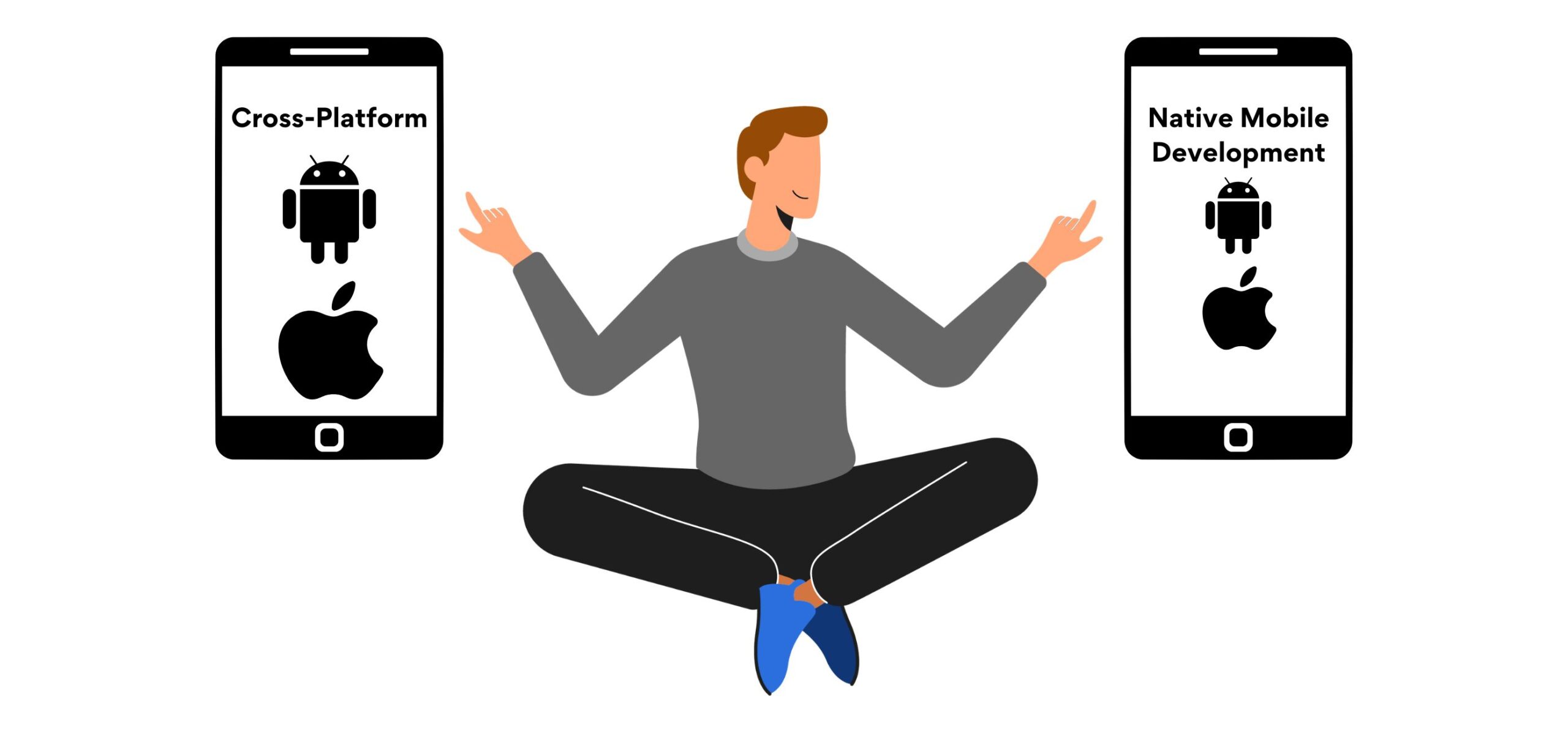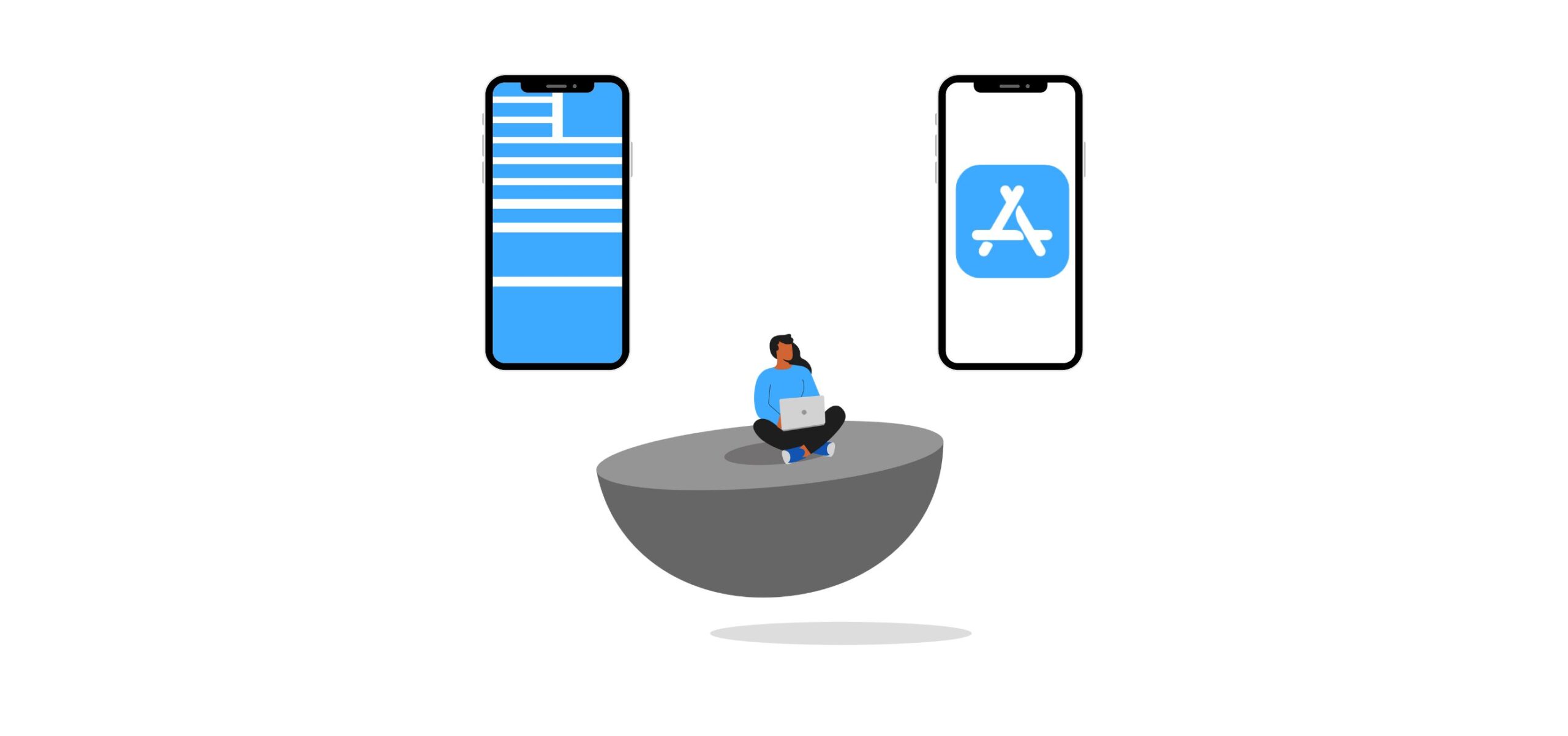Cross-platform vs Native Mobile Development: What Should Enterprises Choose?
There was a time when enterprises only focused on their products to achieve success. However, the technology age has pushed businesses to align with the latest software development trends as well, like cloud computing, AI, AR/VR, the Internet of Things (IoT), automation, and more. Enterprise mobile apps are designed to help companies do just that, allowing them to enhance corporate efficiency, capture market opportunities, and gain a competitive advantage.
However, to build successful mobile apps, enterprises must consider cross-platform vs. native mobile development: which is better, and why? In this blog, we’ll answer these questions by discussing what the two mean, how native vs. cross-platform app development compares in terms of pros and cons, and what you must keep in mind when choosing between the two.
Let’s dive in!
Native vs. cross-platform: How to choose for enterprise mobile apps development?
Given the many benefits of enterprise mobile app development, it’s only natural that businesses are increasingly adopting it. Those who are must ultimately decide which one to opt for – native or cross-platform mobile development.
Native and cross-platform development are fundamentally different in the operating system you want your app to function for. Native mobile apps are built for a specific operating system, such as iOS or Android. Whereas cross-platform apps work on multiple operating systems, allowing businesses to target several platforms through a single source code.
Having said that, choosing cross-platform vs. native mobile development is imperative to business success. To help you decide what’s best for your organization, we’ll explore the two development processes, what they entail, and their pros and cons.
Also, read: Progressive Web Apps vs Native Apps: What Should You Pick?
Native app development
Let’s take a look at the basics of native app development.
What are native applications?
As mentioned earlier, native mobile applications are those developed to target a single operating system, either iOS or Android OS. Hence, depending on your desired operating system (both business and customer-wise), you would opt for native mobile app development that involves coding the application in the OS’s required programming language.
Native Android apps are built using Kotlin or Java programming languages. For native iOS applications, developers commonly use Swift or Objective-C programming languages.
Some of the most popular examples of native mobile apps include WhatsApp, Spotify, Google Maps, and Pinterest, which were developed natively for iOS and Android.
Popular native app tools
Besides OS-specific software development kits (SDK), native app development also requires integrated development environments (IDE). For Android, the most prominent IDEs include Android Studio, Visual Studio Code (VS Code), JetBrains IntelliJ IDEA, and Eclipse with Android Development Tools (ADT). Popular IDEs for iOS include Xcode, Flutter, Visual Studio for Mac, and AppCode.
Why choose native mobile app development for enterprises?
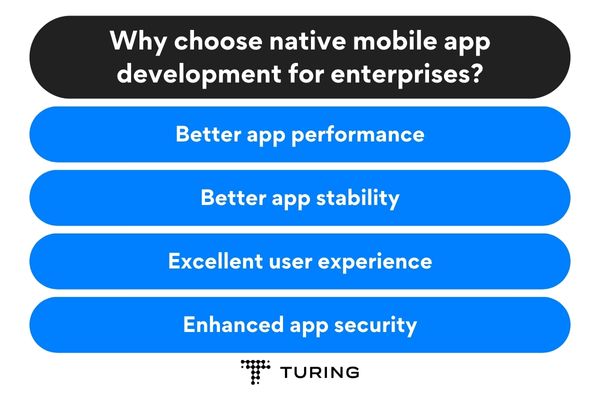
Why choose native mobile app development for enterprises
When considering cross-platform vs native mobile development, here are the benefits you can avail by opting for a native app.
- Better app performance: Native mobile apps perform faster and better than most non-native and cross-platform applications. This is because native enterprise mobile apps are created and optimized for specific platforms, which also involves compiling them using the desired platform’s APIs and programming languages. As a result, native mobile apps are quite efficient, fast, and responsive to a user’s actions.
Furthermore, a native mobile app is smaller in size and has direct contact between its source code and the underlying resources. Hence, the native app provides better performance and faster app store downloads. - Better app stability: Apple and Google are known for their continued support and improvement for the iOS and Android mobile operating systems. For instance, both tech giants offer SDKs, interface elements, and other key development tools for iOS and Android developers to create and enhance mobile apps.
SDK helps speed up app development and provides developers with access to the latest features. Due to this, a native Android or iOS app has high stability in terms of updates and maintenance. Plus, native apps are highly secure as they can access platform-specific in-built security features, which is a major aspect to keep in mind when considering a native app vs. cross-platform mobile applications. - Excellent user experience: Native enterprise mobile apps offer a seamless user experience. During native mobile app development, developers don’t need to worry about any dependency on the app version from various operating systems. As a result, a native mobile app is faster and simpler to customize or configure as per the enterprise’s preferred OS and business goals.
Moreover, a native mobile app can access all the functionalities and features of the intended device, offering a highly-integrated and rich user experience. Native mobile apps can gain access to features like push notifications as well, which are essential for user engagement. - Enhanced app security: App security is another important factor to consider when discussing cross-platform vs. native mobile development. Native mobile apps inherently contain more robust and tailored security features than cross-platform apps. Plus, it’s typically simpler for native mobile app developers to implement intelligent fraud detection, file encryption, and other security elements through the intended platform’s resources and libraries.
Disadvantages of native app development
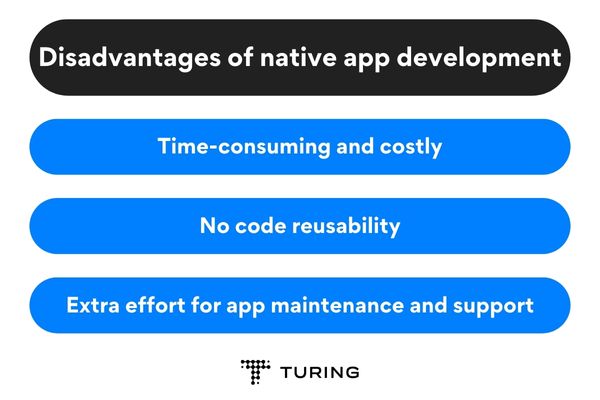
Disadvantages of native app development
While a native app is beneficial, it also comes with its drawbacks, which are the following:
- Time-consuming and costly: If your enterprise wants to target both iOS and Android users, the development will inevitably become costly. You would need to deploy two development teams to create the same app for both operating systems.
Plus, the two teams working in parallel and coordinating to align the app UI/UX will automatically lengthen the development cycle. As such, the development time becomes a crucial deciding factor for cross-platform vs. native mobile development, and enterprises often pick the former for faster deployment. - No code reusability: Building a native mobile app for two operating systems means developers have to write code that cannot be reused from one OS onto another. When compared with cross-platform apps that house reusable codebases, native enterprise mobile app development naturally involves more time, money, and effort.
- Extra effort for app maintenance and support: While considering cross-platform vs. native mobile development, factoring in costs is essential. As such, enterprises must note that native app development entails a higher maintenance expense.
Most businesses make the mistake of believing that application costs end after its release. However, a chunk of effort goes into the app’s maintenance and support phase, which also slows down bug fixes. If the development team identifies a bug and wants to push out an important update, updating the same app for both platforms will be more time and resource intensive.
Cross-platform app development
Here’s what you need to know about cross-platform app development.
What are cross-platform applications?
A cross-platform mobile application is developed from a single codebase and targets different operating systems through one development project. Such mobile apps are built on cross-platform frameworks that use a platform-specific SDK (iOS or Android) from a single API.
This helps developers easily access the platform’s various libraries and SDKs, making cross-platform development a popular choice for enterprise mobile app development.
Some of the most popular cross-platform frameworks include:
- React Native – created by Meta (formerly, Facebook), has JavaScript as its programming language
- .NET MAUI – created by Microsoft, has XAML and C# as its programming language
- Flutter – created by Google, has Dart as its programming language
There are various cross-platform mobile apps prominent today, based on these frameworks. The most common examples of such apps include Skype, Instagram, My BMW App, Airbnb, Fox Sports, and Walmart.
Popular cross-platform app tools
Creating a cross-platform mobile app for Android requires the Android SDK installed on macOS, Windows, or Linux. For iOS, the iOS SDK and Xcode are required, along with a macOS device.
Along with these, the relevant IDEs are essential for successful cross-platform development, which are:
- VS Code, Xcode, Atom, Android Studio, and WebStorm for React Native apps
- Visual Studio for Xamarin or .NET MAUI apps
- Android Studio, IntelliJ, and VS Code for Flutter apps
Why choose cross-platform development?
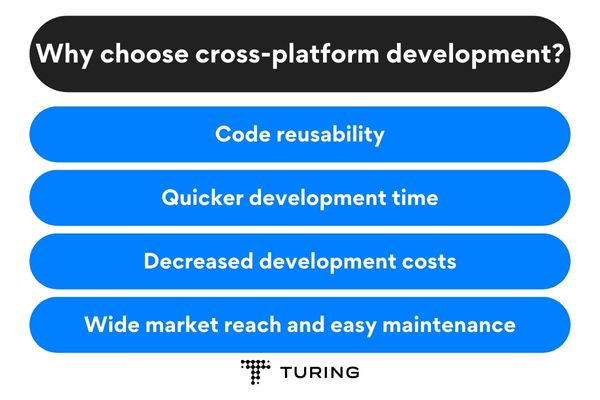
Why choose cross-platform development
When considering cross-platform or native mobile development, there are many reasons to pick the former. Some key ones include:
- Code reusability: One of the biggest reasons to choose cross-platform development for enterprise mobile apps is code reusability. Unlike native app development, developers can store the app’s complete codebase in one place to save time and effort. The unified codebase allows the development team to work on the Android and iOS platforms simultaneously, which ultimately saves expenses.
What’s more, the shared codebase helps to avoid app issues in the UI/UX, security, or functionalities due to longer maintenance cycles. The shared codebase allows developers to make changes that instantly propagate to the required operating systems with little to no modification. - Quicker development time: Since cross-platform apps involve a single development cycle to deploy them on different platforms, the overall development time is faster. Moreover, the app’s code reusability allows enterprises to eliminate the need for separate teams working on separate platform projects, which expedites the time-to-market as well.
- Decreased development costs: As mentioned earlier, considering expenses for cross-platform vs. native mobile development is important. In this case, cross-platform is often the better choice as it entails a single development team instead of two, which automatically reduces development costs.
Plus, for enterprises using tools like React Native to create both mobile and web apps, developers can use a majority of the code and other key assets to do so. This shortens the cross-platform development cycle, resulting in reduced costs and more importantly, higher value for money as the app begins gaining traction. - Wide market reach and easy maintenance: Since cross-platform development is faster and cheaper, enterprises can easily deploy an app on both operating systems. This is lucrative for businesses aiming to reach more users and collect data to test a prototype, hypothesis, or app idea on multiple platforms.
Moreover, updating the cross-platform app is easier as developers have to deal with one codebase. This means, whatever changes or updates need to be made after obtaining user data can be easily implemented to ensure quick maintenance. Plus, every app build targeting the two operating systems will use the same code, allowing developers to maintain app consistency.
These are extremely beneficial for growing businesses, making cross-platform a clear winner for most enterprises considering cross-platform vs. native mobile development.
Disadvantages of cross-platform development
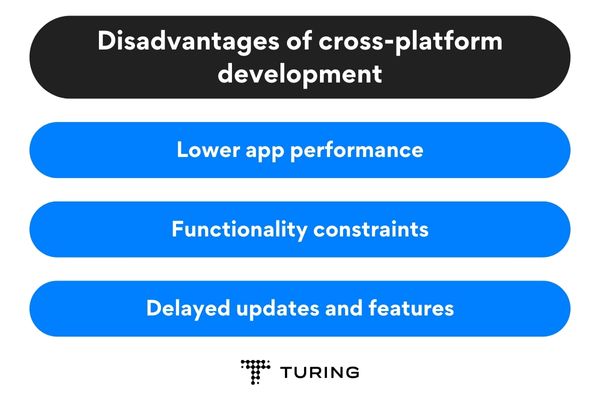
Disadvantages of cross-platform development
While cross-platform development is rewarding, you must be aware of its limitations as well. These include:
- Lower app performance: One of the biggest drawbacks of cross-platform mobile apps is their low performance and speed. Cross-platform apps need a rendering process and an additional abstraction layer, which reduces their speed and also hampers performance.
Moreover, a cross-platform framework bundles custom runtimes to run the mobile app for communication with the platform-specific services. This adds another computation level to the app, further reducing its performance. Hence, enterprises wanting to deploy high-performant apps often pick the latter of cross-platform vs. native mobile development. - Functionality constraints: Cross-platform mobile apps must adapt their functionality and design for specific devices, platforms, and operating systems. This requires extra effort from the mobile app development team to tackle individual differences for various platforms and devices, causing difficulty during feature implementation and resulting in constrained functionality.
This, combined with the lower app speed and performance, ultimately hampers the user experience as well. - Delayed updates and features: Another aspect most companies overlook when considering cross-platform vs. native mobile development is the app updates. Whenever Apple or Google releases a new update or feature for their OS, cross-platform mobile apps have to wait to support the new release. This is because a cross-platform app would require a separate update to access the latest features or updates, while the SDK for a native app gets updated quicker.
Cross-platform vs. native mobile development: What should enterprises choose?
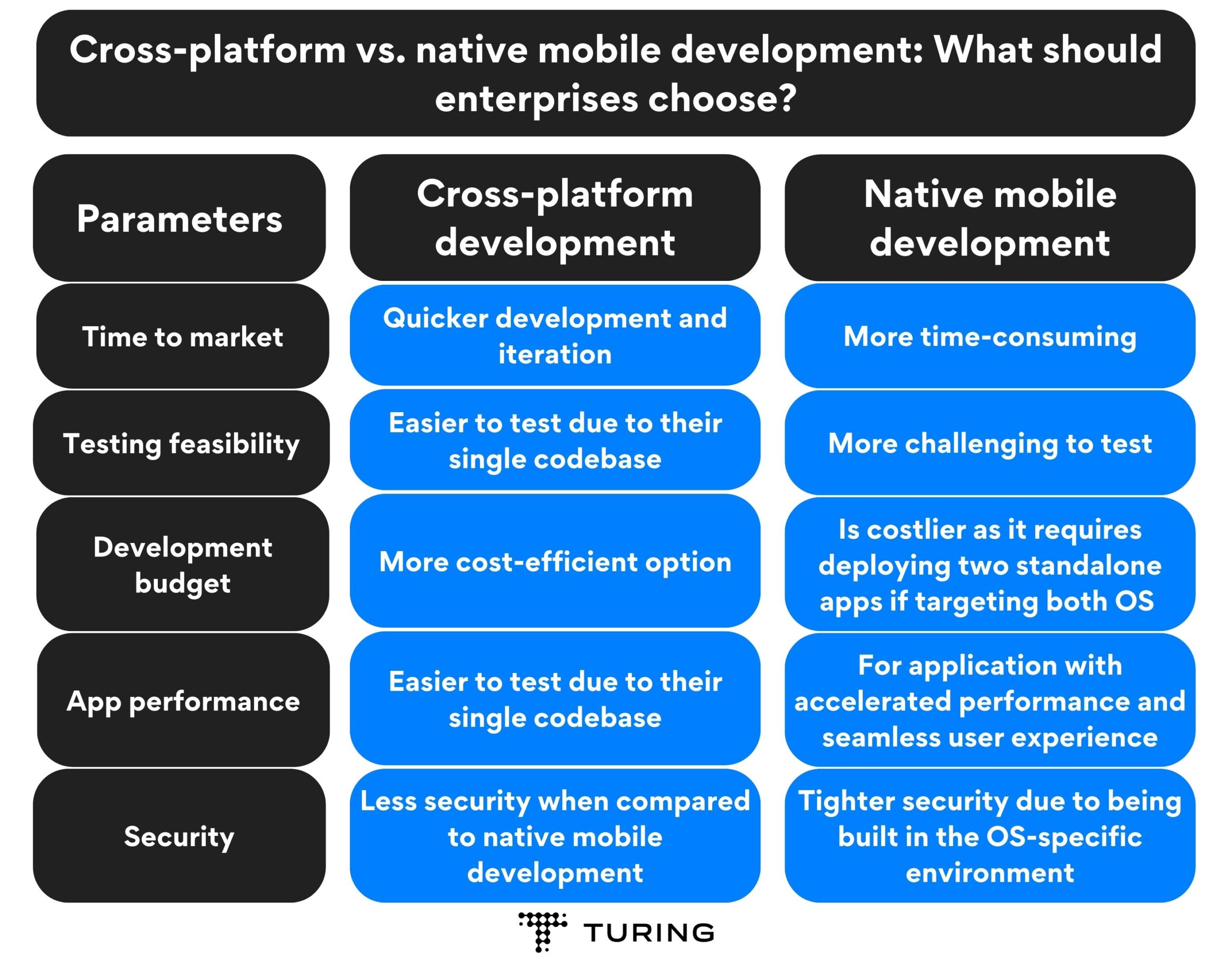
Cross-platform vs. native mobile development: What should enterprises choose?
As you may have understood by now, both native and cross-platform development have their distinct pros and cons for deploying enterprise mobile apps. So, which one should you pick for your business?
Deciding between native vs. cross-platform is crucial, and to pick the right one, you need to consider a few key factors. These include:
- Time to market: One of the biggest deciding factors when considering cross-platform vs. native mobile development is the time to market. While cross-platform entails quicker development and iteration, native app development is more time-consuming, albeit providing a more consistent user experience.
So, if your business needs to deploy the app quickly to start obtaining quality user feedback, cross-platform development would be the better option. - Testing feasibility: Your enterprise mobile app development process will remain incomplete without a proper testing round. Deciding between native and cross-platform development plays a crucial role here too, as native apps are more challenging to test as they involve individual testing for different app versions of the different operating systems. Contrarily, cross-platform apps are easier to test due to their single codebase.
If you have the time and resources to invest in a proper native app testing phase, you can go ahead with it. However, if you lack the resources and want to quickly ship the product, opt for cross-platform development. - Development budget: As evident already, cross-platform is a more cost-efficient option than native mobile app development. The latter involves deploying two standalone apps when targeting both operating systems, which would require hiring more developers, investing more resources, and ultimately, spending more money.
So, if you’re on a tight budget and the limitations don’t seem too problematic, choose cross-platform development. However, if you have the budget and want to prioritize user experience and app updates, native app development should be your choice. - App performance: How you want your app to perform will also influence the choice between cross-platform vs. native mobile development. Mobile applications often entail high computing requirements, specifically for gaming apps. If your enterprise needs an application with accelerated performance and seamless user experience, a native app is the best fit.
However, if that’s not your enterprise goal and you’d rather leverage a wider audience reach and quicker time-to-market, opt for a cross-platform mobile app. - Security: When considering native vs. cross-platform for your enterprise mobile app development, you must emphasize security too. Security is critical, especially for apps that store and manage large amounts of data, such as a banking mobile app. In such cases, a native app is better as they have tighter security due to being built in the OS-specific environment. Native app development also entails access to native libraries, allowing developers to ensure app encryption.
However, if you want to prioritize maintenance, a cross-platform mobile app would be the better fit. As mentioned earlier, cross-platform app development involves easier maintenance due to the shared codebase. Moreover, since you’ll be dealing with just one app instead of two standalone ones, maintenance costs will be lower too.
Summing things up
KBV Research’s data suggests that the overall enterprise app market size will reach $468.2 billion by 2027. Within this sphere, the mobile enterprise app market is projected to grow at 15% CAGR from 2022 to 2030, reaching $268.14 billion by 2030. Clearly, enterprise mobile apps are rapidly gaining popularity, but to build them efficiently, you must choose wisely when considering cross-platform vs. native mobile development.
Although both native and cross-platform development can help you build a successful app, you must consider the tools, frameworks, benefits, and limitations of the two to ensure efficient development. Moreover, understanding the in and out of both development paths will help you determine which mobile developers you must hire, and allocate resources accordingly.
Turing’s mobile app development services are designed to help enterprises achieve rapid business transformation. As such, we provide expert mobile app developers proficient in the required technologies to ensure application success and accelerated business growth. Book a call with us today and experience what a robust enterprise mobile app can do for you.
Join a network of the world's best developers and get long-term remote software jobs with better compensation and career growth.
